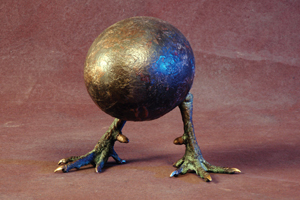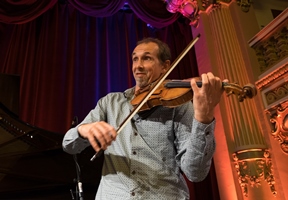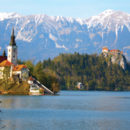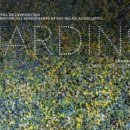
Domen Slana – Art. Nature. Purpose.
Domen Slana, is a creator rather atypical in the field of contemporary visual art which is often known typically as ultraconceptual and nonconformist and hard to define. Although accustomed to being raised and educated in an artistic environment, both parents, Dora Plestenjak and France Slana, being painters and important names in the fine art world in Slovenia.
The artist made himself known using an artistic discourse more settled but not lacking novelty and originality. On the contrary he found a natural organic modality to create, in accord with the environment, to connect the dissonant artistic shapes in harmony with nature, which is his main source of inspiration.
His work communicates a taciturn melancholy of the past and acts as a reminder of the great masters of the nineteenth century. Notable is the influence of the impressionist and post-impressionist periods, an influence that Domen Slana translates into forms with their own personal expression. His landscapes, being oils and watercolours show an almost patriarchal attention to natural detail, a continued awe at the force of nature which continues to reinvent itself and reappear in similar but different forms. In this way his landscapes and the objects he creates reveal the phenomenological transformation of nature. Playing with the organicity of the elements which form the artistic material, shown in his primary form, it offers him the possibility to decontextualize the object and to place it in an artistic universe which is perfectly in concordance with contemporaneity. So a branch becomes a chair, an old forgotten object which has lost any function gains in the present day a purpose. In the vision of Slana the organicity is structural and not formal and this is clear in the way the artist generates and conceptualizes the object whose structure can be defined by excellency in the abstract field.
The colour and the light are those vital elements which are emboldening in a movement the whole sensitive organism of his works. The paintings and also the sculpture-objects contain a lyrical dramatism which has a linear constant rhythm which reveals in a figurative way the emotion. Remarkable is his care for the utility of the artistic product, as the artist himself explains his own work, to create something that can have a practical application, emphasizing an ethical extension of the object. The disjunction between everyday objects and the artistic object accurately contracts giving birth to an integrated product, an object with a dual function, aesthetic and utilitarian, practically a definition, avant la lettre of design. His work is haunted by fantastic forms which are represented in the installation and which can be interpreted using intelligent humour as a guideline for the spectator. Birds and strange creatures simplified to their essence in a primary geometrical form borrowed from related worlds populate the space in a ludic way.
The artist with unusual shyness regarding the “Madding Crowd” of the big exhibition reclaims for himself the space to create in a typical rhythm and to avoid competition which defines success using a form of public exposure. As he declares, he does not only create for himself, instead he prefers that everything he does finds its purpose which is to satisfy a necessity, to create an emotion without it being necessary to engage in an intellectual process about the artists intention.
Even though we are speaking about furniture, painting or sculpture the way that the designer, Domen Slana thinks continues to create around his object a stage ambience which involves the public, at the same time offering to the object independence from his own artistic view. Once out of his studio his works become independent and have the capacity to be useful. The ergonomicity of the furniture is the main criteria but this does not disturb a subtle process of mimesis of nature, an almost cathartic process and this gives to each object a sacrosanct property. The materials that he uses such as wood, metal and stone are not empty of their symbolic extension, a certain awe exists which is generated from this deep respect for nature within the modality he uses. Slana does not brutalize the material, he integrates them keeping their apartness. The wood, the metal and the stone are preserving an ancestral message remembering their home, nature itself. In this way apparently they seem temporarily borrowed by the artist to create a chair, a table, a cradle or any imagined object which will be used in everyday life, the artist seems to borrow for the quotidian fragments from nature transforming these fragments into objects but into art at the same time and this project seems to be the symbolic definition that the artist himself gives to the concept of design.
A visit to the picturesque town of Škofja Loka offered us the pleasure to talk about art, nature and muses with the artist Domen Slana in his studio, a unique experience from which we quote an excerpt.
So what is your speciality, what are the most interesting aspects of your art in your view?
My base is my surrounding, you know, I paint mostly landscapes, mostly water landscapes because I live by the water… and it’s difficult to say because I have periods where I concentrate on one thing and then again I start something else, sometimes I combine, it’s hard to say what is the main thing.
Especially in making this chair I noticed that you used a lot of recycled things?
Yes old farming things
So do you have an ideology or an affiliation to the eco movement in art?
I don’t know. It just happened that these kinds of things interest me, I like a lot wood as a material and I like to do something with beautiful things that would go to nothing unless I gave them a new meaning and a new function.
Do you generally integrate popular tradition or the heritage of the area?
Mostly, mostly.
What’s the greatest memory you have about the impact your art has had?
If I earn some money (laughs loudly.)
When you earn money you certainly remember?
Mostly I’m happy when someone I admire gives me good thoughts about my art.
Especially to people in Romania who may not be familiar with you, do you take part in public and civic activities?
I don’t say art should not be like that but personally I am not the kind of man that would be an art activist because I believe art is too intimate a thing to be involved in such instances and also my way of art is not in this manner because I am not a political person and I don’t want to be.
Could you explain your chairs which you are most famous for, how do you start working on them? Why chairs and not something else?
It doesn’t really matter because I see my chairs as useful sculptures but it’s quite hard because when making chairs you have to consider that it should be useful and I don’t want to make a chair that is not useful because otherwise I think I should do something else as a sculpture like a sculpture, not a useful sculpture, if I make a chair I want to make it useful.
This chair for example is very comfortable because it’s a very nice chair?
Ergonomically speaking…
Do you have any particular artistic dream you haven’t fulfilled yet would you like to do something that you didn’t manage until now?
Well I don’t have any big plans because I think things are coming by themselves, I think you develop as an artist through your work. If you work a lot ideas come by themselves if you only wait for an idea there would be nothing… because ideas come through work.
Is there a routine or a specific pattern of your work? Do you have a tight schedule? Do you work whenever you like?
No I don’t have a tight schedule. I’m not that kind of person.
So you may work ten days in a row and other three days not work at all. Of course it’s very random I mean it’s no routine, unless something has to be done.
What is the purpose of your lifestyle?
It’s all connected, I don’t take it as work the people take something they don’t like to do, I enjoy work, I like work.
How do you sell your art how do you make people notice? Do you have regular exhibitions?
Slovenia at the moment is a very art unfriendly country.
Why would you say unfriendly?
Because if I compare past times it was much better for artists, it’s, I don’t know, people don’t have a lot of money; other things became more important for them. We are bombarded all the time by all these stupid commercials, all these stupid things became more important than some spiritual things and so on and that is the consequence I think.
So is it harder to sell?
It’s much harder!
Than 10 or 20 years ago?
It’s much harder, the past times it was much better. Also the country the government policy is very, very unfriendly for artists.
And what about your presence abroad?
Well if I’m honest I sold much more of my chairs abroad than here in Slovenia.
Nobody is a prophet in his own country
Yes probably, probably.









